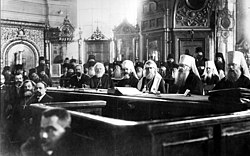Sobor
- For usage as a church building, see Katholikon.

Sobor (Church Slavonic: съборъ, "assembly") is a formal gathering or council of bishops together with other clerical and lay delegates representing the church to deal with matters of faith, morality, rite, and canonical and cultural life.[1] The synod in the Western churches is similar, but it is distinguished by being usually limited to an assembly of bishops.[1]
The term is found among those Eastern Orthodox Churches that use a Slavic language (the Russian, Ukrainian, Bulgarian, Serbian and Macedonian Orthodox Churches), along with the Romanian Orthodox Church.
Assembly
The presence of clerical and lay delegates is for the purpose of discerning the consensus of the church on important matters; however, the bishops form an upper house of the sobor, and the laity cannot overrule their decisions.[citation needed]
Kyivan Rus chronicles record the first known Ukrainian church sobor as having taken place in Kiev in 1051. Sobors were convened periodically from then on; one notable assembly held in 1415 formed a separate metropoly for the church in the Grand Duchy of Lithuanian lands.[1]
Important sobors in the History of the Russian Orthodox Church are:
- The Stoglavy Sobor (Sobor of a Hundred Chapters) in 1551
- The Moscow Sobor of 1666–1667, to deal with disputes surrounding the ecclesiastical reforms of Patriarch Nikon
- The All-Russian Sobor of 1917, which restored the Moscow Patriarchate and elected Saint Tikhon as the first modern Patriarch of Moscow
- The All-Russian Sobor of 1988, called on the 1000th anniversary of the Baptism of Rus' to guide the church in the wake of glasnost and the loosening of the Soviet grip over the church
A bishop may also call a sobor for his diocese, which again would have delegates from the clergy, monasteries and parishes of his diocese, to discuss important matters. Such diocesan sobors may be held annually or only occasionally.[citation needed]
